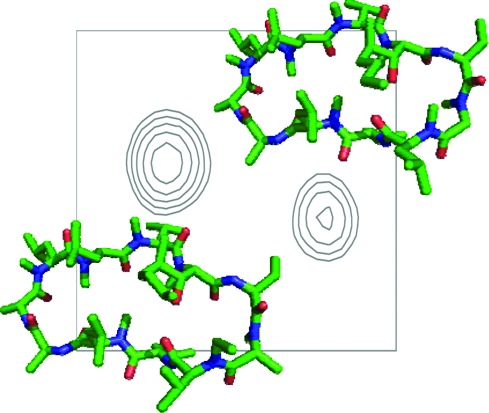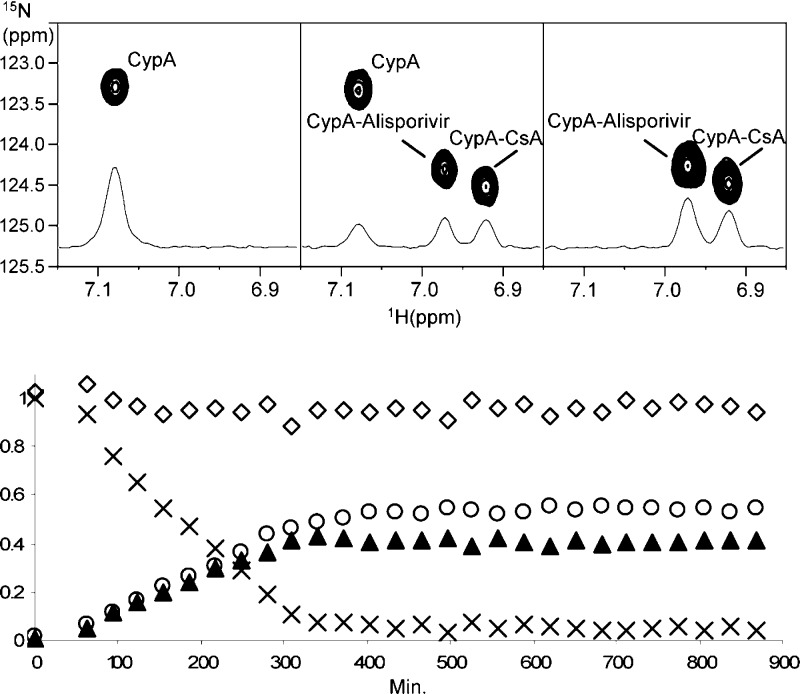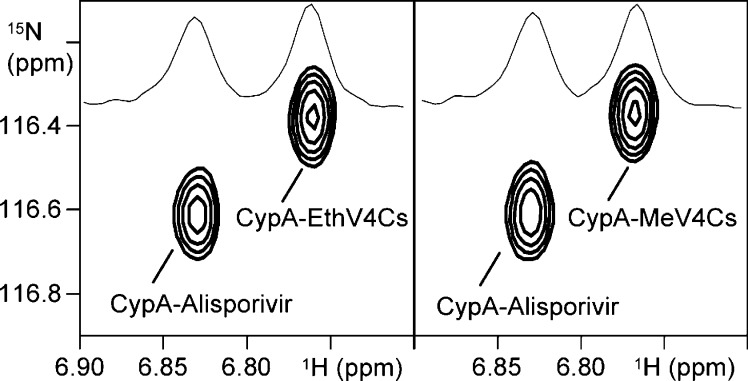Abstract

Cyclosporine A (CsA) and its chemical analogues EthVal4Cs, MeVal4Cs, and Me(d-Ala)3EthVal4Cs (Alisporivir) all interact with cyclophilin A (CypA). The latter Alisporivir is a nonimmunosuppressive CsA derivative that has potent anti-HCV properties in clinical trials. We show here that NMR spectroscopy can be used to rank this series of related pharmacological molecules despite their high affinity for the target protein and low solubility in water. The novel method is based on the possibility to detect distinct NMR signals from the different protein complexes in a mixture. The method has enabled us to distinguish subtle effects of discrete chemical modifications of the parent molecule on the affinity of the ligands for the target protein.
Keywords: Nuclear magnetic resonance, Alisporivir, cyclophilin A, ligands, proteins
Common wisdom holds that the experimental measurement of ligand/receptor binding parameters requires concentrations of both partners of the order of the dissociation constant (KD) to be determined. Whereas this puts NMR spectroscopy in a favorable position to determine the interaction parameters for many biologically relevant molecular interactions, pharmacological ligands often have KD values in the nanomolar range. Fluorescence spectroscopy with its superior sensitivity seems better suited to characterize such ligands but does require fluorescence of the ligand or the receptor to change upon interaction. Low solubility in water is another recurrent issue when characterizing the binding properties of pharmacological ligands, whereby the addition of inorganic solvent and their effect on the protein and protein binding have to be carefully controlled.
Within a given series of (un)related ligands, one typically looks for a relative ranking of the molecules and potentially for information on the identity of the binding site. Competition experiments are the most obvious choice for such a ranking. We propose here the use of NMR spectroscopy in a competition experiment that gives simultaneous relative KD values for the ligands and also qualitative information on the binding site. We demonstrate the method by ranking the binding of the N-methyl d-Ala3/N-ethyl Val4 cyclosporin A (named Alisporivir) toward the human cyclophilin A (CypA) as compared to its mother compound cyclosporin A (CsA) and two chemical intermediates, the N-ethyl Val4 Cs (EthV4Cs) and the N-methyl Val4 Cs (MeV4Cs). Alisporivir is a nonimmunosuppressive analogue of CsA (Figure S1 in the Supporting Information) that presents better antiviral properties than CsA inhibiting HCV subgenomic replicon replication.1,2 Ranking the ligands for CypA binding might help to establish whether differential affinity can explain the biological observation of Alisporivir's superior antiviral character.
When complexing the protein with one or the other ligand, we had previously noticed3 that the differential chemical shift changes, that is, between CypA−CsA and CypA−Alisporivir, were very limited and localized but clearly could be observed for a couple of resonance peaks (Figure 1 and Figure S2 in the Supporting Information). Moreover, with KD values expected in the nanomolar range, the chemical exchange of the ligands should be slow on the NMR time scale and hence allow for the simultaneous observation of the free CypA, CypA−CsA, and CypA−Alisporivir resonances in the [1H,15N]-heteronuclear single quantum coherence (HSQC) spectrum of a mixture of the different molecules.
Figure 1.
Upper part: Details of [1H−15N] HSQC showing resonance of residue Arg 55 of the free CypA and in the CypA−CsA and CypA−Alisporivir complexes. Superimposed are the 1D projections. From left to right, HSQC corresponding to time points 0, 341, and 744 min. Lower part: Evolution of the integrals of the resonances of Arg55 in the CypA−CsA (plain triangles) or CypA−Alisporivir (circles) complexes or in CypA (crosses), during loading of the free protein by a 1:1 Alisporivir:CsA mixture of the ligands dried on the tube walls from a chloroform solution. The sum of the signals is represented by diamonds. Time points are every 33 min, corresponding to the duration of an HSQC, except for the first HSQC of 66 min. The experiment was performed on a 900 MHz Bruker spectrometer equipped with a cryogenic probe head, using a standard 5 mm tube and a concentration of CypA of 240 μM.
A 1:1 CsA:Alisporivir mixture from individual 5 mg/mL stock solutions in chloroform of both undecapeptides was directly deposited in a standard NMR tube. The chloroform was evaporated under nitrogen flux, leaving a white solid layer containing both ligands at the glass interface. 15N-labeled CypA protein solution was introduced in this tube, and sequential [1H, 15N]-HSQC spectra were recorded. Whereas the resonances corresponding to the free CypA protein were initially the only ones detected, novel resonances that had been assigned to both CypA complexes3 gradually appeared (Figure 1). Integration of these peaks in a series of HSQC spectra showed a linear decrease of the free CypA peaks, reflecting the complete loading of the protein with the ligands. Peak integrals corresponding to CypA in its complex with one or the other ligand showed simultaneously a first phase of linear increase. The identical increase of the CypA−Alisporivir and CypA−CsA peak integrals during the dynamic phase of ligand desorption testifies that both compounds are equally available to the protein. When we dried a mixture with a 2:1 ratio of Alisporivir and CsA in the NMR tube, the slope of increase of both CypA−Alisporivir and CypA−CsA peaks reflected this proportion (Figure S3 in the Supporting Information), giving an additional control on the initial amounts deposited.
After this desorption phase, when peaks corresponding to free CypA had nearly disappeared, a novel equilibrium with differential loading of both ligands set in. For the sample started with a 1:1 ratio of CsA and Alisporivir (Figure 1), we indeed found a differential redistribution of the Cyp protein between CypA−Alisporivir and CypA−CsA. The CypA−Alisporivir complex represents 59 ± 2.4% of the total protein as an average over the integration of nine resonances with differential chemical shift in a high resolution spectrum at 900 MHz (Figure S2 in the Supporting Information). The procedure was repeated with results within the standard deviation in several independent experiments (Figure S4 in the Supporting Information). A control HSQC experiment performed after 2 and 7 days showed that this ratio remains constant and hence corresponds to a true equilibrium value.
We compared in a similar manner the loading of CypA with a 1:1 mixture of Alisporivir:EthV4Cs but found in this case that the CypA−Alisporivir and CypA−EthV4Cs complexes are almost identical once the equilibrium is reached (Figure 2 and Figures S4 and S5 in the Supporting Information) (51 ± 2.9% of CypA−Alisporivir). Similar results were obtained with Alisporivir and MeV4Cs (53 ± 2.7% of CypA−Alisporivir) (Figure 2).
Figure 2.
Details of [1H−15N] HSQC showing resonances of residue Phe67 of [15N]-CypA in the CypA−Alisporivir, CypA−EthV4Cs, or CypA−MeV4Cs complexes. Superimposed are the 1D projection. Experiments were performed as in Figure 1. [15N]-CypA was incubated for 15 h with a mixture of 1:1 Alisporivir:EthV4Cs (left spectrum) or Alisporivir:MeV4Cs (right spectrum) dried in 5 mm NMR tubes.
To see how this translates in relative affinity constants, we can write down the equilibrium equations for CypA binding to CsA and to Alisporivir:
and
Dividing both equations by one another, we readily obtain
The latter ratio [CypA−Alisporivir]/[CypA−CsA] can be directly deduced from the peak integral ratio I(CypA−Alisporivir)/I(CypA−CsA) as determined above. The first ratio [CsA]/[Alisporivir] reflects the equilibrium concentration of both ligands and corresponds to their relative solubility. In our precise case of CsA and chemical derivatives, the solubility in water is a limiting factor, and the multiple conformations of at least CsA4 preclude the use of 1D NMR spectra to evaluate the relative solubility of the compounds based on the sole peak intensities. Therefore, 100 μL of a saturated aqueous solution of Alisporivir or chemical derivatives was loaded on a reverse-phase column to evaluate their relative solubility. The surface of the peak of absorption at 215 nm monitoring the elution from the column directly reflects the solubility in water and was identical for all compounds (Figure S6 in the Supporting Information), leading to a value of 1 for the ratio of the ligand concentrations at equilibrium. As a result, the ratio of dissociation constants KD(CypA−CsA)/KD(CypA−Alisporivir) is thus directly reflected by the ratio of both CypA−Alisporivir and CypA−CsA complexes.
KD values for the CypA/CsA complex based on fluorescence spectroscopy by Trp intrinsic fluorescence changes,5 surface plasmon resonance,6 and mass spectrometry-based method7,8 have been reported in the literature and generally vary between 10 and 200 nM. We should notice that the synthesis of a fluorescent CsA analogue was required to narrow down the Trp fluorescence based value of 42 ± 50 to 11 ± 1 nM.5
Taking this latter value of 11 nM for the KD CsA binding constants to CypA,6 a KD value of 7 nM can be calculated for Alisporivir. This correlates with the better in vitro anti-PPIase activity and anti-HCV activity of Alisporivir as compared to other Cs derivatives.1,2 MeV4Cs and EthV4Cs do not have the methyl moiety on the Cα of residue 3 that characterizes Alisporivir but show both nevertheless practically the same affinity improvement as Alisporivir as compared to CsA. Although in agreement with previous functional studies that showed consistently a lower IC50 value for both compounds as compared to CsA,7,8 this conclusion is somewhat unexpected as residue 4 in the Cs cycle is not directly bound by CypA (Figure S2 in the Supporting Information). Our results hence emphasize the importance of this chemical modification to confer a better affinity to CypA as compared to CsA.3
The here-described NMR method thus allows the determination of the relative affinity of submicromolar ligands in a mixture, even when they display low solubility in water. The absence of any cosolvent and the integration of control steps such as the initial slope are additional benefits. As we have shown with a series of CsA ligands, we were able to dissect the subtle impact of discrete chemical modifications on the binding affinity. This could prove very useful in the initial steps of improving an active molecule that will often require increasing its affinity for the protein target.
Experimental Procedures
NMR spectroscopy Successive [1H,15N]-HSQC were acquired to monitor the loading of the Alisporivir, CsA, EthV4Cs, or MeV4Cs molecules dried on the glass wall of the NMR tubes from 5 mg/mL chloroform solutions on [15N]-CypA in buffer 50 mM NaPi, pH 6.35, 60 mM NaCl, 1 mM EDTA, and 1 mM DTT. Independent experiments were repeated several times on a Avance II 800 MHz Bruker spectrometer equipped with a 3 mm dual resonance (BBI) probehead, varying the concentrations of the [15N]-CypA protein (175, 225, and 350 μM) preparation, the ligand solutions in chloroform, and acquisition parameters of the [1H,15N]-HSQC. Three millimeter tubes were used with sample volumes of 160 μL. These experiments allowed us to set up the experimental conditions for the final experiments on the 900 MHz and ensured the reproducibility of the experiments.
Final experiments were performed on a 900 MHz Bruker spectrometer equipped with a cryogenic probe head on 240 μM [15N]-CypA, in a standard 5 mm tube filled with 600 μL. Acquisition parameters for the kinetics experiments were 8 scans per increment, with 3072 and 256 complex points in the direct and indirect dimensions, respectively, and a repetition delay of 0.8 s.
Additionally, once the [15N]-CypA was fully loaded with the ligands in the here above-mentioned experiments, [1H,15N]-HSQC of high resolution were acquired to allow peak integration at equilibrium: for Alisporivir/CsA, 32 scans, 4096 and 512 complex points in the 1H and 15N dimensions, respectively, with a d1 of 1.5 s; and for Alisporivir/MeV4Cs or EthV4Cs, 32 scans, 4096 and 512 complex points in the 1H and 15N dimensions, respectively, with a d1 of 1.0 s. A control HSQC was further recorded after 2 and 7 days to ensure that the proportion of the observed complexes remained constant over time. Spectra were acquired at 293 K (20 °C).
For data analysis, the peak integrals were normalized against an invariant and intense peak in the successive spectra (I97). Integration was performed with the Topspin 2.1 software (Bruker, Karlsruhe, Germany). [15N]-CypA protein expression and purification were as described in ref (3).
Reverse phase chromatography of Cs was used for the quantification of CsA, Alisporivir, EthV4Cs, and MeV4Cs relative solubility in water. One hundred microliters of a saturated aqueous solution of each ligand, dissolved at room temperature for several hours, was injected on an Agilent C18 column (Zorbax 300SB-C18, 4.6/150 mm, 5 μm) equilibrated in 0.05%TFA. Elution was performed with a mobile phase of 80% acetonitrile in 0.05% TFA. The elution was monitored at 215 nm, and the peak surface at 36% acetonitrile was integrated to compare the amount of molecule injected on the column. The absolute solubility of the Cs molecule in water was estimated to 10 μM based on a molar absorption coefficient for each peptide bond of the cyclic peptide of 1000 M−1 cm−1 at 215 nm.9
Acknowledgments
We thank Debiopharm, Switzerland, for a generous gift of Alisporivir and CsA and Dr. Wenger (Wenger Chemtech, Riehen, Switzerland) for the Met4Cs and Eth4Cs compounds.
The NMR facilities were funded by the Région Nord, CNRS, Pasteur Institute of Lille, European Community (FEDER), French Research Ministry, and the University of Sciences and Technologies of Lille I. We acknowledge support from the TGE RMN THC (FR-3050, France).
Supporting Information Available
Representation of the Alisporivir molecule (Figure S1), residues with distinct [1H,15N] resonances in CypA−CsA and CypA−Alisporivir (Figure S2), evolution of the integrals of Arg 55 resonance in CypA−Alisporivir and CypA−CsA in a solution containing a 2:1 mixture of Alisporivir:CsA (Figure S3), comparison of two independent experiments of loading a 1:1 mixture of Alisporivir:EthV4Cs unto CypA (Figure S4), comparison of the loading of CypA with CsA, Alisporivir, or EthV4Cs (Figure S5), and chromatograms of reverse phase chromatography (Figure S6). This material is available free of charge via the Internet at http://pubs.acs.org.
Supplementary Material
References
- Paeshuyse J.; Kaul A.; De Clercq E.; Rosenwirth B.; Dumont J. M.; Scalfaro P.; Bartenschlager R.; Neyts J. Hepatology 2006, 43, 761. [DOI] [PubMed] [Google Scholar]
- Coelmont L.; Kaptein S.; Paeshuyse J.; Vliegen I.; Dumont J. M.; Vuagniaux G.; Neyts J. Antimicrob. Agents Chemother. 2009, 53, 967. [DOI] [PMC free article] [PubMed] [Google Scholar]
- Landrieu I.; Hanoulle X.; Bonachera F.; Hamel A.; Sibille N.; Yin Y.; Wieruszeski J. M.; Horvath D.; Wei Q.; Vuagniaux G.; Lippens G. Biochemistry 2010, 49, 4679. [DOI] [PubMed] [Google Scholar]
- Altschuh D.; Braun W.; Kallen J.; Mikol V.; Spitzfaden C.; Thierry J. C.; Vix O.; Walkinshaw M. D.; Wuthrich K. Structure 1994, 2, 963. [DOI] [PubMed] [Google Scholar]
- Liu Y.; Jiang J.; Richardson P. L.; Reddy R. D.; Johnson D. D.; Kati W. M. Anal. Biochem. 2006, 356, 100. [DOI] [PubMed] [Google Scholar]
- Zeder-Lutz G.; Wenger R.; Van Regenmortel M. H.; Altschuh D. FEBS Lett. 1993, 326, 153. [DOI] [PubMed] [Google Scholar]
- Billich A.; Hammerschmid F.; Peichl P.; Wenger R.; Zenke G.; Quesniaux V.; Rosenwirth B. J. Virol. 1995, 69, 2451. [DOI] [PMC free article] [PubMed] [Google Scholar]
- Hubler F.; Rückle T.; Patiny L.; Muamba T.; Guichou J.-F.; Mutter M.; Wenger R. Tetrahedron Lett. 2000, 41, 7193. [Google Scholar]
- Kuipers B. J.; Gruppen H. J. Agric. Food Chem. 2007, 55, 5445. [DOI] [PubMed] [Google Scholar]
Associated Data
This section collects any data citations, data availability statements, or supplementary materials included in this article.




